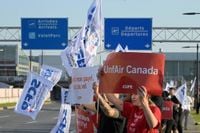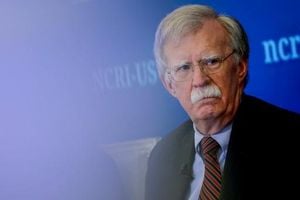Air Canada’s airports across the country were transformed into battlegrounds on September 1, 2025, as more than 10,000 flight attendants walked off the job, triggering the airline’s first strike by cabin crew since 1985. The abrupt halt in operations left over 100,000 travelers stranded worldwide, many caught off guard at the peak of the summer travel season. Picket lines sprang up in every major airport, and the ripple effects were felt far beyond Canada’s borders—families marooned at London’s Heathrow, vacationers in limbo, and a nation suddenly reminded of just how essential flight attendants are to keeping the country moving.
The strike was the culmination of months of tense negotiations between Air Canada and the Canadian Union of Public Employees (CUPE) Air Canada Component. After eight months at the bargaining table, the two sides remained at loggerheads over pay and the thorny issue of unpaid work performed by flight attendants before and after flights. The union, representing a workforce that is overwhelmingly female, voted a staggering 99.7% in favor of strike action, signaling deep frustration and determination among its members.
As flight attendants took to the picket lines, Air Canada responded by suspending all operations, grounding its fleet of roughly 700 daily flights. The chaos was immediate. According to PressProgress, approximately 130,000 people were affected each day, with around 25,000 Canadians stranded abroad. Passengers like Keelin Pringnitz, who found herself stuck at Heathrow with her family, faced the surreal prospect of being offered a flight to the United States—without any further assistance. "It didn't go over well with the line. Nobody really seemed interested, everybody seemed a little bit amused almost at the suggestion, or exasperated, because it is a bit ridiculous to offer to take stranded passengers to a different country to strand them there," Pringnitz told reporters.
Montreal resident Alex Laroche, 21, and his girlfriend watched their $8,000 European vacation hang in the balance. Initially frustrated with the union’s decision to strike, Laroche’s perspective shifted as he learned more about the flight attendants’ grievances. "Their wage is barely livable," he said, echoing a sentiment that would soon be echoed by many Canadians as the details of the dispute became public.
At the heart of the conflict was the issue of compensation. Entry-level flight attendants at Air Canada earn about $27,000 per year before taxes—less than the federal minimum wage. Many younger attendants, especially in expensive cities like Vancouver, reported living with up to ten roommates or in trailers parked in lots just to make ends meet. Reagan Goulding, a flight attendant with nearly 30 years’ experience, described the mounting pressures: "The amount of service we do has definitely increased. The amount of work on the ground, boarding times, de-planing times, assisting passengers." She added, "They can't afford to live. So they're living with 10 people to a room. One of the other flight attendants I was talking with the other day, she was living in a trailer parked in a parking lot."
Unpaid work, long a sore point for flight attendants, has ballooned in recent years. "Even us, as flight attendants, thought it was okay at one time, and we were so conditioned to thinking this is acceptable," Goulding said. "It's not. We're breaking that cycle, and it stops now."
The federal government, led by Jobs Minister Patty Hajdu, intervened swiftly. Citing the economic risks of a prolonged shutdown, Hajdu invoked Section 107 of the Canada Labour Code, ordering flight attendants back to work and into binding arbitration. This rarely used provision allows the minister to act unilaterally to maintain “industrial peace,” bypassing Parliament altogether. "The talks broke down. It is clear that the parties are not any closer to resolving some of the key issues that remain and they will need help with the arbitrator," Hajdu announced. She acknowledged that full resumption of services could take days, as the Canada Industrial Relations Board would oversee the arbitration process.
CUPE’s Air Canada Component, however, did not go quietly. In a statement, union president Wesley Lesosky lambasted the government’s move: "The Liberals have talked out of both sides of their mouths. They said the best place for this is at the bargaining table. They refused to correct this historic injustice through legislation. Now, when we're at the bargaining table with an obstinate employer, the Liberals are violating our Charter rights to take job action and give Air Canada exactly what they want—hours and hours of unpaid labour from underpaid flight attendants, while the company pulls in sky-high profits and extraordinary executive compensation."
CUPE filed a challenge in Federal Court, arguing that the government’s use of Section 107 violated the constitutional right to strike under the Charter of Rights and Freedoms. According to PressProgress, CUPE claimed the intervention "disregarded, undermined and effectively nullified the constitutional right to strike held by the Union and its members under s.2(d) of the Charter of Rights and Freedoms and under international law."
The government’s reliance on Section 107 is not without precedent. It has been used three times between August and December 2024 to force railway, longshore, and postal workers back to their jobs during labor disputes. Labor experts warn this “eyebrow-raising” pattern undermines the government’s stated respect for the right to strike. Alison Braley-Rattai, a labor studies professor at Brock University, described the standoff as a “perfect storm.” “I think this was just an ‘enough is enough’ moment that, like many such moments, has been a long time in the making from the union’s perspective,” she explained.
Stephanie Ross, a labor studies professor at McMaster University, noted that while the government frames its actions as protecting the public from disruptions, its consistent use of Section 107 tends to favor employers’ interests. "It tells us something very disappointing about the attitude in the federal government: employers and their interests, and the way that they understand their interests, are going to be at the centre of their decision-making, even though, of course, they frame it as trying to protect the public from disruptions of economically essential services and industries," Ross said.
Air Canada’s CEO, Michael Rousseau, admitted that the company had not made provisions to ensure passengers wouldn’t be stranded, as they expected the government to intervene. "Well, we thought, obviously, that Section 107 would be enforced, and that (the union) wouldn’t illegally avoid Section 107," Rousseau told BNN Bloomberg.
The dispute also laid bare longstanding gender inequities. While Air Canada negotiated a 42% wage increase over four years with its pilots—a predominantly male workforce—the company sought government intervention rather than bargaining with the mostly female flight attendants. "It tells you something about the perspective of the employer, in terms of the relative value of male-dominated versus female-dominated work, and the way that their business model is heavily dependent upon the gendered discount that they can enjoy by not paying flight attendants for some portion of their required work duties," Ross observed.
Despite the disruption, public sentiment appeared to favor the flight attendants. Polling data indicated that a majority of Canadians supported their right to strike, perhaps recognizing the pent-up frustration after a decade-long contract and years of pandemic and inflationary pressures.
As the arbitration process unfolds, the outcome could reshape not just compensation at Air Canada but set a new industry standard for flight attendants nationwide. With the world watching and a workforce galvanized by years of “shared injustice,” the legacy of this strike may reach far beyond the airport gates.




